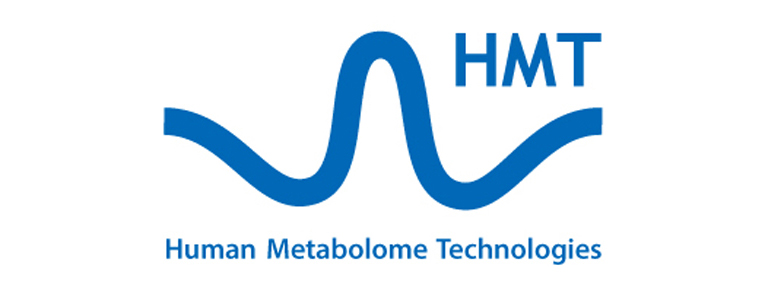| Human Metabolome Technologies (6090) |
|
||||||||
Company |
Human Metabolome Technologies Inc. |
||
Code No. |
6090 |
||
Exchange |
Mothers of Tokyo Stock Exchange |
||
Industry |
Service Industry |
||
President |
Ryuji Kanno |
||
Address |
246-2 Mizukami, Kakuganji, Tsuruoka-city, Yamagata |
||
Year-end |
End of March |
||
URL |
|||
*Share price as of closing on the end of June 20. Number of shares outstanding is as of March 31.
ROE and BPS are based on actual results of the previous term end. |
||||||||||||||||||||||||
|
|
*Forecasts are those of the Company. From the current fiscal year, the definition for net income has been changed to net income
attributable to parent company shareholders (Abbreviated as parent net income).
|
| Key Points |
 |
| Company Overview |
|
On the other hand, close attention must be paid to the steady expansion of the metabolome analysis business. Although the company completed its fourth fiscal year since getting listed on December 2013, the total operating CF for the four periods was a surplus 82 million yen. Although it is not a substantial amount, compared to other biotechnology venture, which has nearly a billion yen deficit every term, we can see the advantage of the company with a metabolome analysis business that is steadily profitable. 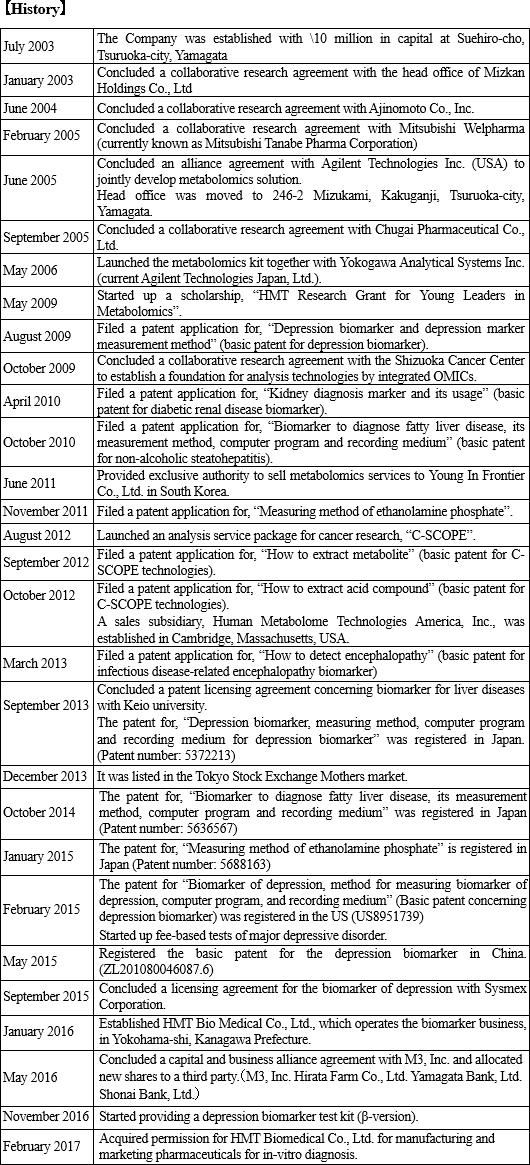 Metabolome analysis techniques had been used for various purposes such as fundamental biological research, development of pharmaceutical products, disease biomarkers, etc., and were expected to expand the demand in the future. Therefore, upon establishment of the CE-MS system, Human Metabolome Technologies Inc. was established in July 2003 to commercialize the method chiefly by Professor Soga, Professor Masaru Tomita, also from Keio University, and the office of Keio University. It was the first venture company originated from Keio University, with a financial support from Keio University's entrepreneurship fund. In 2008, Mr. Ryuji Kanno became the president of the Company. Before taking up this position, Mr. Kanno who was the Vice President & CEO of Agilent Technologies Japan, Ltd., a Japanese subsidiary of Agilent Technologies, a global company that develops, manufactures, sells, and support chemical analysis equipment and electric & electronic measurement equipment in the field of life science., which, had been for some time in business relationships with HMT and Keio University. President Kanno promoted research and development of the Company's core technologies and also began organizing and establishing more specific commercialization process and business models. At the same time, he began preparation for the Company to be listed on the stock market in order to accelerate its growth speed through enhancing the Company's visibility and raising funds for research and development. The Company got listed on the Mothers Section of the Tokyo Stock Exchange in December 2013, ten years after its establishment. "To contribute to people's health and joyful lives through research and development using the up-to-date metabolome analysis technologies for children in the future."  ① Significance of Social Presence
Biomarkers are in vivo substances that are used as indicators to assess the current state of specific diseases. Blood sugar" for diabetes, "γ-GPT" for liver function disorder, and "uric acid" for gout. are the representative examples of well-known and widely used biomarkers.The Company discovered a biomarker for "major depressive disorder", one of the current major social issues, and is developing diagnostic agents to quantify the condition of the disease. Because there is no prevailing method to objectively measure the status of depression, despite the increase in the number of patients with depression, some serious problems are emerging regarding the therapy of depression. For example, patients who would have been cured if they had properly treated are still suffering or in overprescription. If the diagnostic agents using the Company's biomarker become to be widely used, these issues are expected to be solved, and social loss will be subsequently reduced. This social significance cannot be overlooked to understand the Company. ② Excellent Technological Capacities
The Company is highly recognized thanks to the "metabolome analysis technology" which is used to examine complicated behavior of metabolites in human bodies to identify biomarkers. The biomarker for depression is just an example. With the technology, the Company is expected to identify and develop various new biomarkers in the future. ③ Stable Business Model
The Company's current core business is the "commissioned metabolome analysis business", supporting research and development activities of research institutions and pharmaceutical companies, that occupies the greater part of its sales. Sales of FY March 2017 were 913 million (up 29.8%, YoY) and operating income was 501 million (up 66.8%, YoY), showing steady income. On the other hand, the "biomarker business", which is expected to achieve significant growth in the mid- to long-term, is still operated in a small scale and experiencing losses. However, the Company has already established a balanced business model, in which the profit generated from the commissioned metabolome analysis business is invested into the biomarker business for its growth. This model is notable among many bio-venture companies that are suffering from gaining profit. ◎What is Depression?
Depression is a type of mood disorder, and is a brain dysfunctional state for various reasons such as accumulated physical and mental stress. Because the brain is not functioning properly, people in the depressed mood feel negative and low-esteem. This causes a vicious cycle in which people with depression feel more stress for matters that they could otherwise handle. The "major depressive disorder" refers to the state in which depression mood continues even after the sources of stress are removed. In this regard, it is distinguished from adjustment disorders or some anxiety disorders and is considered a brain dysfunction, instead of a mere response to stress. (Note: "Major" of the major depressive disorder means "primary" and does not mean "serious" depression.) ◎Number of depression patients in World and Japan
In 2012, the World Health Organization (WHO) announced that at least 350 million people were with depression which is a mental disorder. Almost 1 million lives are lost due to suicide every year, and over half of them are assumed to be due to depression. According to the "Patient Survey" conducted by the Ministry of Health, Labor, and Welfare (MHLW) every three years targeting health facilities across the country, the total number of patients with mood disorders including depression increased from 430,000 in 1996 to 950,000 in 2011 (2.2x). The "Patient Survey" shows statistical data of the number of patients who visit health facilities. It is known that the consultation rate of patients with depression is low. Thus, according to the MHLW, it is suspected that the actual number of depression patients might be larger. 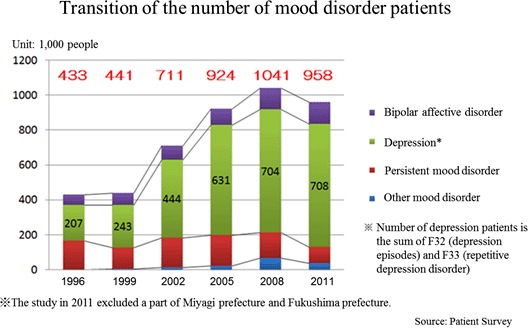 In Japan, economic losses due to depression and suicide are estimated to be about 3 trillion yen. If there were no such losses, GDP would increase about 2 trillion yen (an estimate by the Ministry of Health, Labour and Welfare, 2010). Economic losses around the world are estimated to be about 62 trillion yen in 2002 (Screening for Depression in Adults: A Summary of the Evidence. Ann Intern Med. 2002.). The current economic losses are estimated to be over 100 trillion yen. ◎Treatment of Depression
If someone is diagnosed as having depression, the common treatment is prescription of "antidepressant drugs." The antidepressant drugs can be categorized into several groups such as selective serotonin reuptake inhibitor (SSRI), serotonin-noradrenaline reuptake inhibitor (SNRI), and tricyclic antidepressant. In addition, anti-anxiety drugs or sleep inducing drugs can be used, depending on the symptom. The important thing under drug therapy is that the patients comply with the prescribed amount and frequency after they are informed the effects and side effects. However, patients with depression often reduce the amount or frequency without doctors' permission as they do not feel the symptom to be very serious, they worry side effects, etc. In these cases, the patients do not show improvement as doctors expect, and the doctors prescribe more drugs or change the types of drugs. That would often result in the delay of recovery or excessive administration of drugs, for lack of trust between doctors and patients. Therefore, it is essential to have objective assessment standards quantifying the state of depression or proving the depression has been cured. The biomarker and diagnostic agents of the depression that the Company is currently working on are extremely important for prompt and appropriate treatment of the disease. <What is metabolomics?>
Living organisms including human beings consist of some parts with various functions such as muscles, internal organs, and bones. "Metabolites" such as amino acids, fatty acids, and nucleic acids are common and major components of these organs. Metabolites play crucial roles for entire life activities. Metabolites are provided by food, and are consumed in the process of daily actions such as exercise. They move in a body and cells in accordance with their functions, and are converted into new substances through various chemical reactions, which are called "metabolism". Adjusting body temperature, breathing, moving heart, digesting and absorbing food, transforming old cells into new ones are all operated by metabolism. The "substance conversion" to a new substance is based on a certain flow called metabolic pathway. One of well-known approaches to understand the mechanisms of a human body is "genomics", analyzing genes. Now, automated sequencing and computer analysis of genetic information (DNA base sequences) is available, and nearly all the information in the human genome has already been deciphered. However, much about the relationship between the roles of genes and diseases remains unknown. Recently, more researchers lean towards investigating metabolic profiles, in addition to genetic information coming out of genome analysis, in order to understand the relationships between a human body and diseases. Consequently, research and use of "metabolomics (metabolome analysis)" targeting all metabolites is becoming increasingly popular.  <What are biomarkers?>
A human body puts various vital functions under high-sophisticated manipulation to minimize internal and external influences, and subsequently keeps the body condition stable. That mechanism is called "homeostasis". For example, body temperature and heartbeat may change temporarily, but return to regular ranges. Diseases lead abnormal homeostasis and metabolic status, which are different from healthy conditions. A metabolite, which concentration keenly reflects the status of a specific disease, is called a biomarker. By measuring a biomarker, the current status of a specific disease can be objectively assessed. Blood sugar as a pancreas function indicator, γ-GTP as a liver function indicator, biomarker PSA for prostatic cancer and biomarker CA19-9 for pancreatic cancer are examples of well-known biomarkers. Biomarkers have been studied for a long time in order to monitor the status of diseases. These days, with new methods to analyze multiple substances with higher sensitivity all at once, study results of various new biomarkers have been publishing one after another. Among the biomarkers that are explored through metabolomics technologies are the followings:  Previously, the company allocated the profit from the "metabolome analysis business," which is the current mainstay business, to the investment in the R&D of the promising "biomarker business," and applied the intellectual property obtained through the R&D to the development of medicines and disease diagnosis, with the goal of growing in the mid to long terms. From the term ending Mar. 2017, the company will accelerate the investment in the biomarker business by procuring funds from the outside in order to flourish in the future. Earnings structure and customers of each business are as follows. 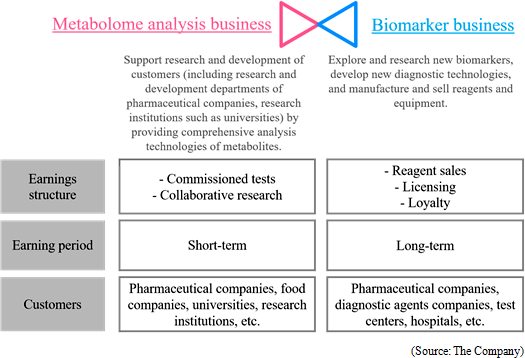 ① Commissioned Metabolome Analysis Business
The Company receives orders from various customers, e.g., private companies such as pharmaceutical companies and food companies as well as universities and public research institutes."Sales were 913 million yen and operating income was 501 million yen for FY March 2017." The scheme of the service is as follows. A customer sends samples to the Company, and then metabolites are extracted from the samples. The extracted metabolites are measured by the CE-MS system, and the acquired data is analyzed. After all, the report is delivered to the customer. The data obtained from the service are used for various purposes; basic biological study, assessment of drug effectiveness and toxicity assessment by pharmaceutical companies, universities, and research institutions, analysis of fermentation process and functional evaluation of functional foods by food companies. The data is contributing to the progress of research and development activities of customers.In recent years, not only healthcare, food, but also interest towards health-related companies is emerging rapidly. ◎Deployment in the Overseas Market
In order to distribute the commissioned metabolome analysis service in Asia, the Company concluded an exclusive sales authority agreement with Young In Frontier Co., Ltd. in South Korea in June 2011. Moreover, the Company hired a sales representative in charge of Asia-Pacific area to develop Asian market including Singapore and Hong Kong, outside of South Korea. Furthermore, in order to expand its business in the North American market, it also established its sales subsidiary, Human Metabolome Technologies America, Inc., in October 2012 at Cambridge, Massachusetts, USA, home to many medical research institutions. In order to further accelerate overseas development, in May 2017, the company established a subsidiary (sub-subsidiary) "Human Metabolome Technologies Europe B.V." in Europe (Netherlands) through HMT-A. ◎"C-SCOPE" -a service package of the commissioned metabolome analysis service for cancer study
In August 2012, the Company launched "C-SCOPE", a service package of the commissioned metabolome analysis service well organized for cancer study. C-SCOPE was developed to respond to the needs; they would like to measure concentrations of specific metabolites changing inside cancer cells with higher sensitivity and higher accuracy. Its technologies are based on unique and efficient metabolites extraction method from cancer cells and highly sensitive analytical system.Cancer is the number one cause of death in Japan since 1981 and occupies about 30% of the recent total causes of death. According to the MHLW, the costs for cancer research are increasing year by year; in 2012, ¥35.7 billion were spent. It is an urgent task for many pharmaceutical companies to develop effective new anticancer drugs. The "Warburg effect" is the phenomenon that most cancer cells have glycolytic rates of several to dozens of times to that of normal cells. Although this effect was proposed as far back as over 80 years ago, the research on the effect made little progress since there was no method to comprehensively measure metabolites back then. Thanks to the dramatic advancement in metabolomics technologies in recent years, development of anticancer drugs which act as metabolic inhibitors are underway. The Company's metabolome analysis technology based on the CE-MS system is considered as one of the effective analysis systems applicable at each stage of cancer research; from the basic study of cancer biology to clinical application in the process of anticancer drugs development. ②Biomarker Business
The Company considers the business related to biomarkers, which play an important role in occasions such as early diagnosis or monitoring treatment effects, as a driver for future growth, and is proceeding with biomarker discovery and development of clinical test drugs through collaborative research and development with universities, pharmaceutical companies, and diagnostic drugs companies. "Sales was million 0 JPY and operating loss was 198 million JPY for FY March 2016" The Company develops new diagnostic methods by using biomarkers, which were acquired through its own R&D, or biomarkers introduced from outside. Additionally, through the process of product development and clinical development, the Company produces and sells in vivo diagnostic drugs and diagnostic equipment. The sales in this business are composed of cooperation money for R&D from pharmaceutical companies in cooperative research, milestone revenues, and loyalty gained from the sales of the drugs when they are commercialized. ◎Intellectual Property Policy
The personnel in charge of intellectual property and contracts works on patent application and requests for examination of all projects, and are in close collaboration with the patent attorneys of the Company and its collaborative research institution. They are also responsible for negotiation concerning collaboration research agreements and development of agreement documents. The Company attempts to maximize its rights when obtaining a patent of newly discovered biomarkers. Since the scope of the rights differs depending on the marker, the Company generates patent application documents in a way that would cover a wide scope of the rights such as chemical structure of the biomarker, usage for diagnostics and drug development, detection method and measurement equipment. Furthermore, the Company makes it a principle to file international patent applications in accordance with the Patent Cooperation Treaty, in anticipation for the future license agreement and market based on the information of clinical test drugs, test equipment companies and pharmaceutical companies of various countries. As of June 2017, the "basic patent" on the method of biomarkers of depression diagnosis etc. has been registered in Japan, the US and China (Europe has been filed). The patent on the method of measuring ethanolamine phosphate (PEA) has been registered at all four stations in Japan, the US, China and Europe. ◎Example of Biomarker Business: Depression Biomarker
The Company especially focuses its research and development on a) the central nervous system disorder such as depression (e.g. mood disorder and mental disorder) for which there are few objective diagnosis methods b) diseases that have become social problems such as metabolic syndrome, including hepatitis and diabetes, and their related diseases. Its current focus is the biomarker for depression. Diagnosis of major depressive disorder is conducted using the diagnostic standards provided by the American Psychiatric Association or the standards of the World Health Organization (WHO). However, both of them largely reflect the subjective view of the doctor or patient, and unlike other diseases, no diagnostic method has been established on the basis of objective indicators. The Company conducted collaborative research with the National Center of Neurology and Psychiatry, and discovered a blood biomarker of major depressive disorder. Blood samples were collected from approximately 30 patients and 30 healthy people, and the blood components were compared through metabolome analysis using the CE-MS system. As a result, the patients with major depressive disorder showed lower concentration of (PEA) in their serum. Through further analysis, it was found that a) PEA is a specific biomarker for major depressive disorder, and b) PEA level will return to the healthy standard range when MDD is treated. 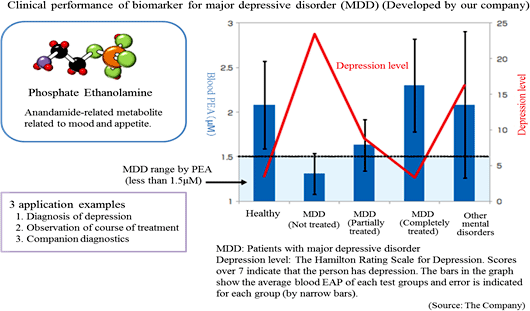 *Companion diagnostics: Refers to clinical tests to predict effects and side effects of pharmaceutical products before administration. By checking the responses of individual patients towards a drug before treatment, more effective drug administration can be provided.
Subsequently, the Company developed a technology to measure extremely low-concentrated PEA in the blood, which was not possible to detect with the conventional enzyme method. Based on this technology, the Company developed the "PEA test kit using the enzyme method" (β-version) in 2016. It is of extreme significance that the Company succeeded in the development of a "depression biomarker test kit" (β-version). "Realization of an inspection method that can be processed cheaply and massively" and "Establishment of a technical foundation that can supply reagent kits worldwide" will make it possible to supply PEA tests to 350 million people with depression worldwide. As a result the company's significance of social existence has become even bigger. In addition, it has become possible to shift to a new business development phase that considers concrete markets, product specifications, distribution channel construction, business size, etc. 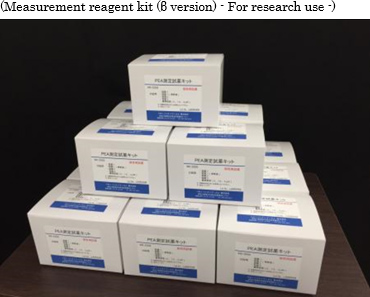 ◎Identification of Disease Biomarkers
The Company uses the following three connections and systems for identifying biomarkers in order to expand biomarker development pipelines.
<Connection with the Customers for Commissioned Analysis or Collaborative Development>
The Company accepts requests from universities and companies for the tests for finding biomarkers. The Company also receives proposals for collaborative development before or after the tests. Currently, a collaborative development project for diabetic nephropathy biomarkers is ongoing.
<Direct Proposal to Researchers and Physicians>
The Company's researchers directly propose research plans for the development of disease biomarkers to researchers or physicians, and establish collaborative study agreement with the institution based on approvals from the collaborative researchers or physicians. The target diseases are chosen according to the number of patients, compatibility to the analysis technologies of the Company, degree of social contribution, and necessity of biomarkers. In addition to major depressive disorder, the Company is working on the development of biomarkers for non-alcoholic steatohepatitis and fibromyalgia.
<HMT Research Grant for Young Leaders in Metabolomics>
The Company offers a grant (HMT Research Grant for Young Leaders in Metabolomics) to graduate students to disseminate the usefulness of metabolomics in the society and nurture young researchers. From the research themes submitted from graduate students across the world, the Company chooses excellent proposals, and supports their research by awarding metabolome analysis service without a fee. Fourteen students have been awarded in the last 4 years. Some of these study results actually led to the identification of biomarkers and evolved to collaborative study with the Company, for example, infectious disease-related encephalopathy biomarker.
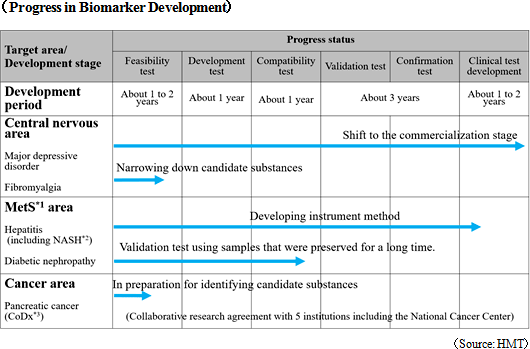 |
| Fiscal Year March 2017 Earnings Results |
 Continued loss due to increased investment for growth
Sales are 914 million yen, up 17.1% year on year (YoY). The metabolomics analysis business remained healthy. Covering the decline in the temporary staffing business, sales increased. The operating loss was 43 million yen. Although the metabolomics analysis business is making stable profits, investment in the commercialization of depression biomarkers is expanding. Orders are solid both domestically and overseas. The orders received for the metabolomics analysis business increased by 30% from the previous term.  Due to the sales growth and the enhancement of productivity, operating income rose 66.8% year on year to 501 million yen. The amount of orders received was 922 million yen, up 30.9% year on year. The amount of orders received at the U.S. corporation (in local currency) grew 72% year on year. 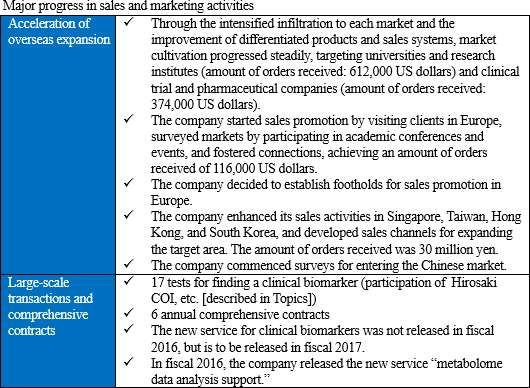  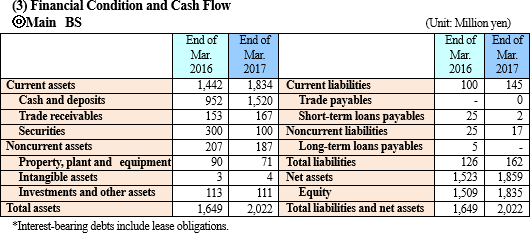  As there was no longer expense for acquiring investment securities, the deficit of investing CF shrank and free CF became positive. Financing CF became positive, because of the increase in the income from the issuance of shares through the exercise of share acquisition rights. The cash position improved. (4) Topics
◎ Hirosaki University participates in COI program
It was decided that Hirosaki University (Aomori Prefecture) would participate in an innovative creation program called COI (Center of Innovation) STREAM, which was adopted and implemented by the Ministry of Education, Culture, Sports, Science, and Technology (MEXT), and the Japan Science and Technology Agency (JST) in 2013.As Aomori Prefecture has the shortest average life expectancy in Japan, Hirosaki University has worked on the research for building a long-lived and healthy society from the early stage. In 2013, Hirosaki University was accepted as one of the country's 12 COI bases, and implemented various initiatives with the cooperation of industries, universities, citizens and government. Thanks to its efforts in 3 years till 2015, the university earned the highest score (S) in the medical health field, in the interim evaluation conducted by a national agency. Hirosaki University COI tackles issues related to the super-aged society in Japan, such as "medical expense reduction", "promoting elderly health", "improvement of QOL", and "extending the healthy life expectancy of elderly people". By analyzing big data on more than 600 items related to the health of Aomori citizens, they aim to develop an algorithm that can predict the onset of dementia and lifestyle diseases, and install this algorithm in software packages and systems to make this software available in order to enable early prediction and intervention for local governments and health-related organizations. Using a ground-breaking technology (CE-MS method) that is able to simultaneously and comprehensively measure ionic metabolites inside the body as a core technology, the company is strengthening its efforts to offer metabolome analysis services to public research institutions such as universities, as well as pharmaceutical and food product companies, and also conduct cohort research for studying the relation between various factors such as the health condition, lifestyle habits, and living environment of people from specific areas and groups over a period of multiple decades. While participating in this program, the company will compare and analyze data obtained through metabolome analysis of blood samples and health-related big data collected by Hirosaki University through a large scale residential health examination (Iwaki Health Promotion Project) in the Iwaki district of Hirosaki City, Aomori Prefecture. By doing so, they will work together to promote the development of a health evaluation method that can assess health level with indices. In addition, they will continue to make efforts to find disease biomarkers using metabolome analysis. The above mentioned efforts of the company make it easier to select and classify groups susceptible to diseases due to health problems, and mean another step toward the so-called "precision medicine," which provides them with the most appropriate preventive medicine. By strengthening the efforts towards cohort research, they intend to improve the evaluation and recognition of the metabolome analysis technology, work to promote its use, and actively engage in precision medicine, which is recognized as one of the medical reforms taking place in the future. ◎ Establishment of a local subsidiary in Europe
They established a second-tier subsidiary in Europe (the Netherlands) through their100% subsidiary, "Human Metabolome Technologies America, Inc. (HMT-A)". It is scheduled to begin operations in July 2017.
 Background for Establishment
Since establishing the distributor HMT-A in October 2012, their corporate group has focused on developing the metabolome analysis business in the North American market, and the number of orders received has been increasing steadily. In October 2016, they made a contract with the US National Institute of Aging (under the National Institute of Health) to collaboratively conduct surveys and research about the mechanism of Alzheimer's disease and seek biomarkers. The development of a business base in the North American market is progressing steadily. Meanwhile, they decided to establish a local subsidiary to further accelerate overseas development of the metabolome analysis business and cultivate the European market. The points related to the cultivation of the European market are as follows. In addition, the Netherlands is located in the center of Europe and the easy access to other countries is considered to be a big advantage. By effectively using the know-how and resources obtained during the startup process of HMT-A and carrying out activities both in the U.S. and Europe, they aim to further accelerate the overseas development of the metabolome analysis business. ◎ Transition to a company with an auditing committee
With the intention of enhancing corporate governance by strengthening the supervisory function of the Board of Directors, the company decided to make the transition from a company with a Board of Auditors to a company with an auditing committee, after obtaining the approval at the 14th Annual Shareholders Meeting to be held on June 24, 2017.Two of the three outside directors or auditing committee members are currently outside auditors. The third is Mr. Toshio Nagae, a new outside director with abundant experience and broad insight as a manager in pharmaceutical companies such as PeptiDream, Inc. and Sanofi K.K. They look forward to benefitting from his insightful suggestions. |
| Fiscal Year March 2018 Earnings Estimates |
 The metabolomics analysis business will remain healthy, increasing sales. Deficit will augment due to the enhanced upfront investment in the biomarker business.
Sales are estimated to be 980 million yen, up 7.2% year on year. The metabolomics analysis business is forecasted to remain healthy. Due to the active investment in the two businesses, the deficit will expand. Especially, in the biomarker business, the company will invest 315 million yen in R&D, etc. with the aim of releasing reagents for PEA measurement by the end of this term.
(2) Activities in this term
◎ Metabolomics analysis business
The environment surrounding this business is changing considerably. Especially, metabolomics has evolved from academic technology for conventional universities, laboratories, etc. to industrial technology. In these circumstances, the companies in the health-conscious market, including new healthy food products, such as functional foods, sports, food products, sleeping, and stress, have interests in the effectiveness of metabolomics, which grasps the health conditions of human beings, and new markets are emerging. In the field of medicine development, metabolomics is considered effective for researching intestinal bacteria, early detecting neuropsychiatric disorders, such as dementia and Alzheimer's disease, diagnosing them, developing treatment methods, and putting medical technologies, including medicines for refractory diseases, into practice. In such a favorable trend, the company will implement the following measures this term, and steady growth is expected.   ◎ Biomarker business
As mentioned in the previous report, the company became able to offer PEA tests to 350 million depression patients around the world, by developing "a kit of reagents for PEA measurement with the enzyme method" (β version) in Nov. 2016. As the company took a significant step in FY ended March 2017, it plans to implement the following measures in the fields of product development, clinical development, pharmaceutical affairs, and business development, and take a dynamic step toward commercialization.  ◎ Product development
The company assumes two kinds of PEA measures: "the measurement using a kit of measurement reagents and versatile automatic equipment for biochemical testing at large hospitals and clinical test centers" and "the measurement using a measurement reagent cartridge and POCT measurement equipment at general internal medicine and mental clinics." For the former, it is necessary to develop a kit of measurement reagents compatible with automatic equipment. For the latter, it is essential to develop POCT measurement apparatus and measurement reagent cartridges indispensable for clinical measurement at co-researching institutions. The development of measurement reagent kits compatible with automatic equipment leads to the foray into the health checkup market, which is much larger than the market of diagnosis. As for POCT measurement equipment, the company will develop a prototype (before mass production) by the end of this term. (*)POCT (Point Of Care Testing) Real-time test using a compact analyzer and a swift diagnosis kit in a medical scene. It includes all kinds of clinical tests conducted at a hospital laboratory or a place other than an outsourcing center. A wide range of testing places and application methods can be assumed. Since medical staff conduct POCT beside a patient, testing time can be shortened and the patient can feel familiar. These merits are said to contribute to swift, appropriate diagnosis and nursing, prevention of diseases, health promotion, and the improvement of quality of life (QOL) of patients. ◎ Clinical development
In order to apply for the approval for the production and sale of pharmaceutical products, it is indispensable to obtain and analyze a sufficient volume of data. To do so, it is necessary to collect clinical data from medical doctors and hospitals, which can be said to be third parties for the company. Accordingly, the company will promote many facilities and medical doctors to conduct a PEA measurement test, and clarify the gap from their hypothesis and the variation of doctors' judgements. In order to achieve early full-scale commercialization, it is indispensable to find a practical case that would help obtain the approval, by specifying a condition such as "a measurement reagent only for diagnosing depression with the decline in the PEA level in the blood" rather than "diagnosing all kinds of depression," after the feasibility tests by many facilities and medical doctors. In addition, it is considered important to do academic research for backing up clinical studies. Accordingly, the company will elucidate the mechanism for the drop in the PEA level and study the effects of the administration of antidepressants by using model animals in collaboration with Japanese universities, and clarify the mechanism for the PEA generation in the brain by using biochemical methods in cooperation with a U.S. national institute, while considering future global business operation. ◎ Pharmaceutical affairs
In Feb. 2017, the company obtained the approval for the manufacturing and sale of in-vitro diagnostic agents. Then, it became possible to outsource the manufacturing of in-vitro diagnostic agents to an enterprise that has "a license to produce in-vitro diagnostic agents" and sell the in-vitro diagnostic agents produced by an outsource. This is required for obtaining the approval for the sale of the company's biomarker as an in-vitro diagnostic agent in accordance with the Pharmaceuticals and Medical Devices Law.In May, the company received the permission for the "wholesale of pharmaceutical products." If the sale of the company's biomarker as an in-vitro diagnostic agent is approved in accordance with the Pharmaceuticals and Medical Devices Law, it will become possible to directly supply this in-vitro diagnostic agent to a broad range of medical institutions, including hospitals, clinics, and clinical test centers. Like this, the company laid the groundwork for future pharmaceutical business. This term, the company will start consulting with Pharmaceuticals and Medical Devices Agency about the application for the approval for the production and sale of pharmaceutical products, and discuss concrete exit strategies. ◎ Business development
The company will proceed with the production of PEA measurement reagent kits (for research), and release them targeting mainly research institutes in Japan in the second half. The basic patent for the PEA enzyme method is pending only in Europe, but the company considers it to be registered soon.  |
| Interview with President Kanno |
|
Q: "Could you sum up FY ended March 2017?"
A: "Both businesses progressed greatly over the year."
The metabolomics analysis business clearly witnessed a further market expansion and the biomarker business has been firmly paving the way towards early commercialization. All in all, both businesses progressed greatly over the year and we were able to take our next important steps towards our great leaps forward in the coming terms.
Q: "Could you tell us about the present state of the metabolomics analysis business and its future outlook?"
A: "In parallel with the market expansion, we would like to further focus on new services to stimulate further growth."
This market is undergoing a massive change. Firstly, the market expansion: Until recently this technology was mostly confined to universities and research institutions, i.e. academia, but in the last few years its user base has expanded into private businesses. And I am being surprised by a growing number of enquiries and approaches from businesses related to "health" such as sports, sleep and stress, in addition to medicines and foodstuffs. This suggests that the utility value of metabolome analysis in the "health industry" is becoming clearer, and we can look forward to a further market expansion. Secondly, the increase in contract prices due to a growing number of repeat orders: Our main clients for this business are the companies and research institutions concerning medicines and foodstuffs; previously, the requests tended to be for the analysis of a food item itself, but more recently there is a higher demand for clinical analyses, to see what effects and influences can be observed when a medicine is given to animals. In addition to conventional comprehensive analyses, we are receiving more orders for targeted analyses, such as the ones to investigate the function of a specific marker. With such diversification of demands, the number of repeat orders from some of Japan's biggest food and cosmetics manufacturers is growing and the contract prices per company are also becoming higher. I feel proud that the growing list of our corporate clients and the increasing number of repeat orders suggest that our company's metabolome analysis technologies are being regarded highly. Since the inception of our company, we have performed over 4,000 analyses in total. This indicates 4,000 reports produced to date, and there is no other company in Japan with this much experience, and even if you look globally, we are one of the top companies in the world. The extremely varied samples included in those 4,000 reports make up an incomparable "big data", and we are also able to offer "interpretations" of analysis results by combining the myriad samples and patterns, in addition to the juxtaposition of analysis results. As a matter of fact, we are receiving an increasing number of orders from various companies to provide interpretations of the analysis results obtained by themselves or external bodies (other companies in the same industry). To exploit this "solution service" as our new source of income, we launched the "metabolome data analysis support" as a new business model in the previous term. We expect this to contribute to our steady growth and it will also serve as a factor to differentiate ourselves definitely from other companies. The search for biomarkers also saw some great developments. I expect that the newly obtained technological patents will take our company's metabolome analysis technologies to a much higher level. We will further invest in discovering more biomarkers including those for cancer. On the back of the market expansion, we would like to further concentrate on the new services to stimulate a further growth. Q: "How about the biomarker business?"
A: "In that year, we were able to take a huge step forward. From here, we will keep pushing forward to enable its commercialization as soon as possible."
One of our biggest breakthroughs was that we opened the door to provide 350 million depression sufferers worldwide with the PEA test with the development of our laboratory measuring reagent kit. But we didn't stop there: on the new product front, we developed POCT equipment; on the clinical development front, we built a new implementation system; obtained the approval for manufacturing and sale on the pharmaceuticals front; and on the business development front, the PEA measuring method was patented in the U.S., China and Europe. All in all it has been a year in which we were able to make a seriously big step forward.The new product development, clinical development, pharmaceuticals and business development fields are positively progressing simultaneously, so if we implement our measures and plans solidly for this term, the early commercialization will become even more realistic. We also believe it is necessary to seek an alliance with the major global manufactures/distributors of equipment and reagents to speed up the commercialization process. However, in order for our company to keep control of sufficient initiatives, it is indispensable that we produce the reagent kits and cartridges, and POCT equipment all steadily, to make the business feasible. We will keep our eyes on the timing while doing what we should do. We have been steadily laying the groundwork and continued our development through raising funds and hiring great talents by listing on stock markets. At the next stage, we will have to go through a period of loss during the current and next terms, as a large amount of investments will become necessary towards clinical and equipment developments for the full-scale commercialization. But after that, we are expecting the sales of reagents as well as the reduced expenses gradually through the shift from the research phase to the business development phase, so the positive turnaround will not be too far away. For these reasons, this term will be a seriously important one. We shall try our best to actualize the commercialization as soon as possible. Q: "Finally, do you have any messages to stockholders and investors?"
A: "We are about to enter our next, rapidly flourishing chapter. Keep an eye on us!"
It's been 3 years since we were listed in 2013. Its effect was finally clearly felt in the previous term. Now, in the next 3 years, we are going to enter our next flourishing chapter. Please keep an eye on us to follow our status quo, and keep your hopes high for our future!
|
| Conclusions |
|
Accordingly, its share price bottomed out and is recovering, although it is still much lower than the highest price since listing. We would like to pay attention to the progress of this term's measures, while seeing whether the company will get on a full-scale, sustainable recovery track. We also would like to monitor the soundness of the metabolomics analysis business and its steady growth. After the company was listed in Dec. 2013, it settled annual accounts for the fourth time in the previous term. The operating CF over the 4 terms is 82 million yen. This amount is not significant, but compared with bio ventures that generate a deficit of hundreds of millions of yen every term, the company has the metabolome analysis business, which produces profit steadily, and so it can be considered as advantageous. |
| <Reference: Development of in-vitro diagnostic agents and clinical test equipment for the depression biomarker and business prospects> |
|
The Company has developed the research-use test kit as well as test cartridge and POCT test equipment, and supposes the following two ways of usages of the series of products.  As previously described in the section of 【Business Contents and Business Model】, it is of extreme significance that the Company succeeded in the development of a "depression test kit" (β-version) as it opens up the door to supply PEA tests to 350 million patients in the world. Also, as described earlier, if 350 million patients with depression in the world would receive a test for the initial diagnosis and then 4 other tests for observation during the treatment course per person, the sales target of the Company for FY 2029 will be as follows (The test unit price is assumed to be 600 yen (target sales price of the Company) and test penetration rate is assumed to be 10% in 2029). 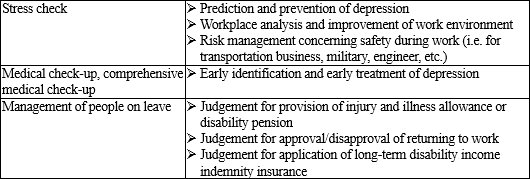 Disclaimer
This report is intended solely for information purposes, and is not intended as a solicitation for investment. The information and opinions contained within this report are made by our company based on data made publicly available, and the information within this report comes from sources that we judge to be reliable. However, we cannot wholly guarantee the accuracy or completeness of the data. This report is not a guarantee of the accuracy, completeness or validity of said information and opinions, nor do we bear any responsibility for the same. All rights pertaining to this report belong to Investment Bridge Co., Ltd., which may change the contents thereof at any time without prior notice. All investment decisions are the responsibility of the individual and should be made only after proper consideration.Copyright(C) 2017 Investment Bridge Co., Ltd. All Rights Reserved. |


